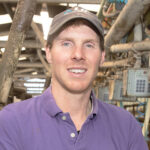Farmer Focus: Focusing on yield with our calving block
 © Tim Scrivener
© Tim Scrivener We are seven weeks into calving at time of writing, with 540 calved and 215 replacement heifer calves born, which is about 60 more than we need.
We are finding our feet with sexed semen and have had better conception rates than last year. In theory, raising more, selling surplus and culling harder down the line is a nice position to be in.
See also: Autumn-calving herds advised to graze now to cut diet costs
Angus heifers appear to have replaced dairy bull calves – undervalued for what they are – on a valuation basis. Unfortunately, a few of our usual beef calf buyers let us down at the last minute.
That said, our primary aim is to profit from milk sales, not beef calves.
The spring calvers are on grass only and being milked once a day. The autumn calvers have transitioned well. They’re in at night and getting 5kg of parlour cake and 1.5kg of soya through the feeder wagon.
After a few early milk fevers we’ve put magnesium chloride alongside the plant-based calcium magnesium product we use to balance the dietary cation-anion difference (DCAD).
Grass intakes for the autumn group are about 6kg dry matter (DM) a head from fresh grass, although we’re leaving paddocks at about 1,800kg DM/ha, rather than 1,500kg DM.
This is because our aims have changed slightly around early lactation management.
In previous years we’d struggled to achieve DM intake from fresh autumn grass, which consequently compromised fertility and reduced peak yield. So, we are leaving a higher residual.
The herd will reset the covers in the spring when they are, hopefully, in-calf and there is less pressure on them.
To maximise profitability as an autumn-calving herd, I think it is important to focus on achieving a peak because of the higher overheads associated with winter housing.
Also, housing at night, rather than bringing a herd in midway through the day to supplement silage before milking, has made things a little simpler for team routine.
As we approach breeding, we’re beginning to check for endometritis four weeks post-calving. We score these checks according to discharge, and iodine washouts are used for any dirty cows.
Breeding starts at the end of November. It would be nice to reduce next year’s autumn block to 10 weeks.

